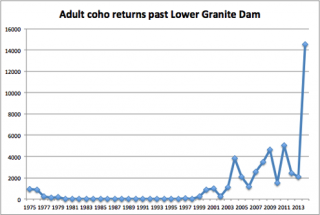Portland, Oregon – Coho salmon are returning from a 20-year absence in the Snake River Basin, surging up the Columbia and Snake Rivers by the thousands and supporting fisheries along the way.
 Coho returns past Lower Granite Dam on the Snake River are nearing 10 times the 10-year average and more than double the previous record of 5,060 set in 2011. Over halfway through the 2014 coho salmon return, about 14,500 coho have passed Lower Granite Dam, by far the largest return since construction of the Snake River dams. Coho were declared functionally extinct in 1985 after counts at Lower Granite flat-lined at zero in the 1980s.
Coho returns past Lower Granite Dam on the Snake River are nearing 10 times the 10-year average and more than double the previous record of 5,060 set in 2011. Over halfway through the 2014 coho salmon return, about 14,500 coho have passed Lower Granite Dam, by far the largest return since construction of the Snake River dams. Coho were declared functionally extinct in 1985 after counts at Lower Granite flat-lined at zero in the 1980s.
Coho salmon once returned to the Clearwater River Basin (tributary to the Snake River) in abundance and supported an important fall tribal fishery.
Earlier efforts to restore coho during the 1960s failed. Snake River coho were never listed under the Endangered Species Act. The Nez Perce Tribe’s reintroduction program began in 1995 with hatchery coho releases into the Clearwater River. For the first time, coho returns are approaching the tribal goal of 14,000 adults returning annually to the Clearwater Basin.
“Reintroduction of coho is succeeding in the Clearwater Basin. The only reason the Nez Perce Tribe has been able to bring them back, and keep them here, is because of this essential Pacific Coastal Salmon Recovery Funding,” said Silas Whitman, Chairman of the Nez Perce Tribe. “The returning coho are being harvested and spawning and part of our cultural connection to these fish has been reestablished.”
The Nez Perce Tribe’s coho program is the result of an agreement through U.S. v. Oregon where the Nez Perce Tribe used surplus coho eggs from the lower Columbia River to reintroduce the species. NOAA Fisheries’ Pacific Coastal Salmon Recovery Fund and Mitchell Act Program have provided the Nez Perce Tribe’s coho program with more than $5 million in funding since 2000.
Many of the returning Snake River coho are caught in tribal and other fisheries in the Columbia River and a Nez Perce tribal fishery in the main-stem Clearwater, North Fork of the Clearwater, Lapwai Creek and Clear Creek.
“In a year of great salmon returns this one stands out because it started from zero,” said Barry Thom, deputy regional administrator of NOAA Fisheries. “Few places in the world can say they have brought back a lost salmon run, but the determined work of the Nez Perce Tribe has done exactly that. That work is benefiting many others.”
For more information on the Nez Perce Tribe’s coho restoration program can be found online here».
Information on NOAA’s Pacific Coastal Salmon Recovery Fund online here».

